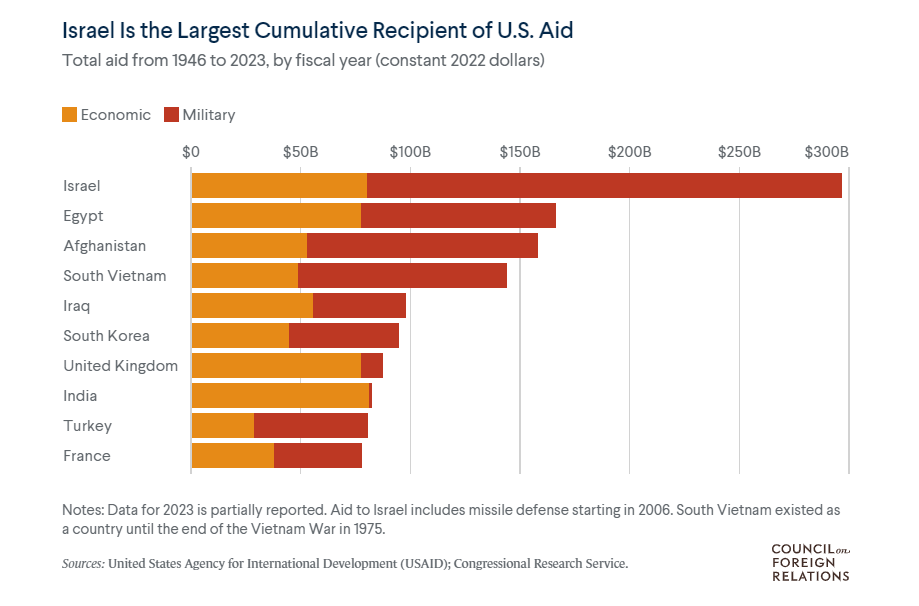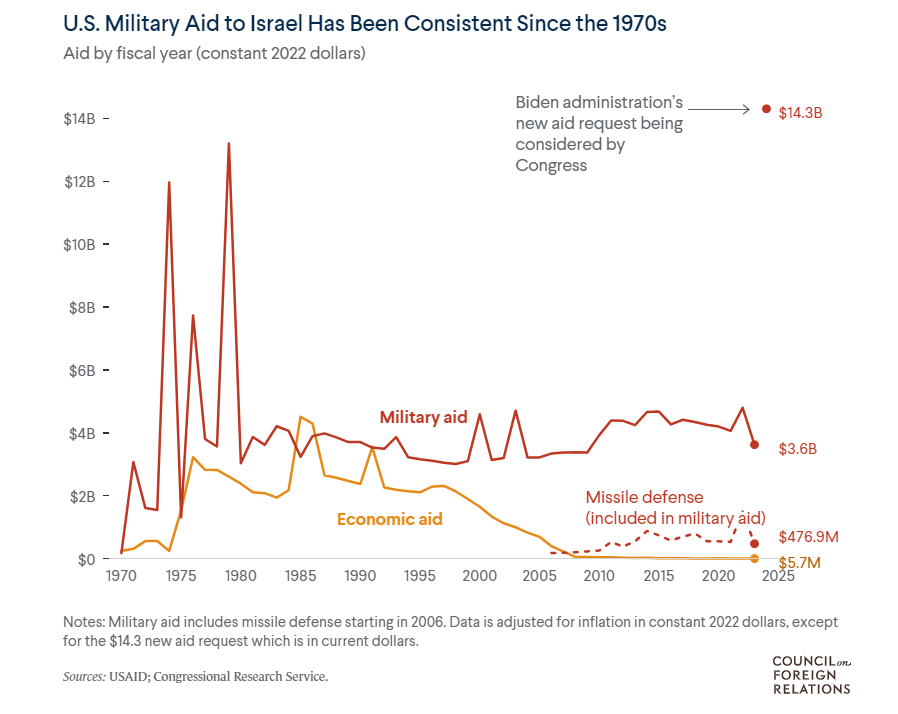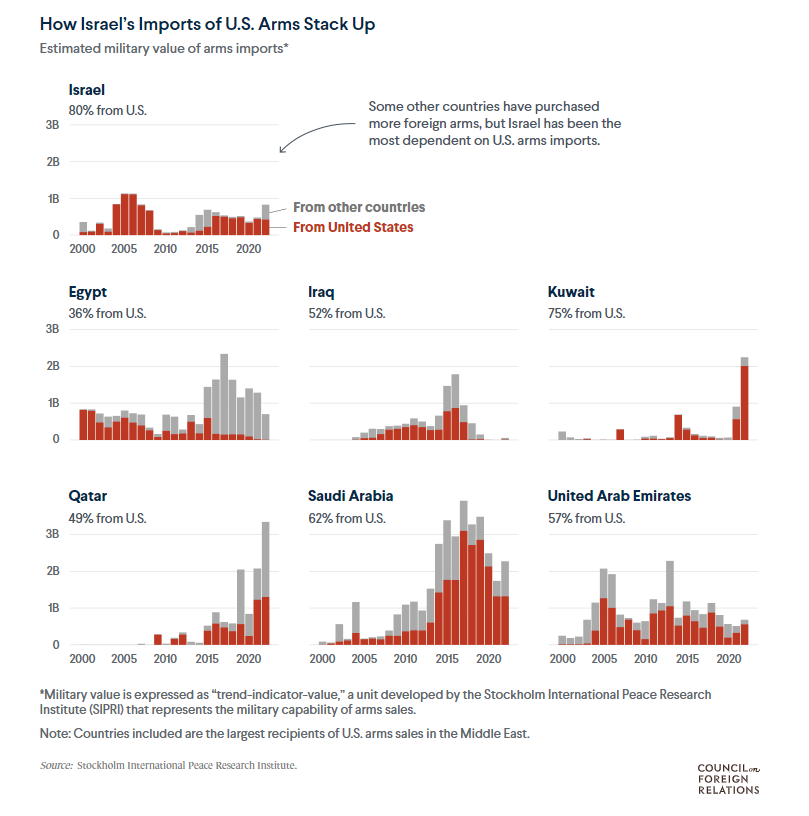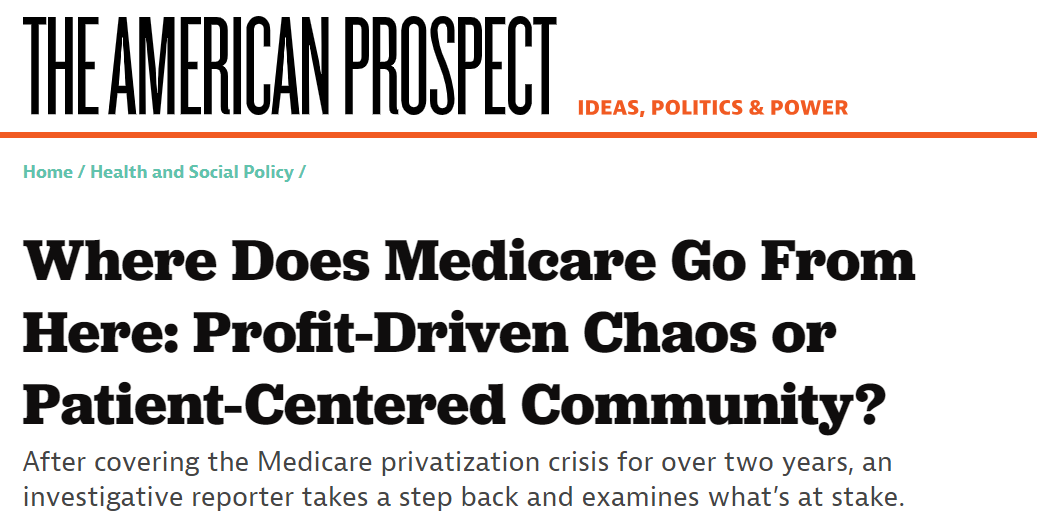Welcome to DU!
The truly grassroots left-of-center political community where regular people, not algorithms, drive the discussions and set the standards.
Join the community:
Create a free account
Support DU (and get rid of ads!):
Become a Star Member
Latest Breaking News
General Discussion
The DU Lounge
All Forums
Issue Forums
Culture Forums
Alliance Forums
Region Forums
Support Forums
Help & Search
Celerity
Celerity's Journal
Celerity's Journal
April 20, 2024
Label: Dangerbird Records – none
Format: 3 x File, FLAC, MP3, WAV, WMA, Single, Stereo
Country: UK & Ireland
Released: Dec 4, 2009
Genre: Rock
Style: Indie Rock

Silversun Pickups - Substitution (2009)
Label: Dangerbird Records – none
Format: 3 x File, FLAC, MP3, WAV, WMA, Single, Stereo
Country: UK & Ireland
Released: Dec 4, 2009
Genre: Rock
Style: Indie Rock

April 20, 2024

Israel has long been the leading recipient of U.S. foreign aid, including military support. That aid has come under heightened scrutiny amid Israel’s monthslong war to eliminate Hamas.
https://www.cfr.org/article/us-aid-israel-four-charts

U.S. and Israeli army officers talk in front a US Patriot missile defense system. Jack Guez/Getty Images
The United States was the first country to recognize the provisional government of the state of Israel upon its founding in 1948, and it has for many decades been a strong and steady supporter of the Jewish state. Israel has received hundreds of billions of dollars in U.S. foreign aid in the post–World War II era, a level of support that reflects many factors, including a U.S. commitment to Israel’s security and the countries’ shared foreign policy interests in a volatile and strategically important part of the world. The two countries do not have a mutual defense pact, as the United States has with allies such as Japan and fellow members of the North Atlantic Treaty Organization (NATO). However, Israel is among a short list of “major non-NATO allies” and has privileged access to the most advanced U.S. military platforms and technologies.
About half of Americans hold favorable views of Israel, according to recent polls. But ongoing U.S. military aid to Israel has come under greater scrutiny amid Israel’s war with Hamas, now entering its seventh month. Israel is responding to the Palestinian militant group’s October 7 terrorist attack that killed more than 1,200 Israelis, the deadliest such attack in the country’s history. Some U.S. lawmakers and foreign leaders, the United Nations, human rights and activist groups, and other parties have voiced growing concern about the scale of Israel’s war to eliminate Hamas. They have been especially critical of its heavy bombing of the Gaza Strip, which has reportedly killed more than thirty-three thousand Palestinians—mostly civilians.
How much U.S. aid does Israel receive?
Israel has been the largest cumulative recipient of U.S. foreign aid since its founding, receiving about $300 billion (adjusted for inflation) in total economic and military assistance. The United States has also provided large foreign aid packages to other Middle Eastern countries, particularly Egypt and Iraq, but Israel stands apart.

The United States provided Israel considerable economic assistance from 1971 to 2007, but nearly all U.S. aid today goes to support Israel’s military, the most advanced in the region. The United States has provisionally agreed (via a memorandum of understanding) to provide Israel with nearly $4 billion a year through 2028, and U.S. lawmakers are considering billions of dollars in supplementary funding for Israel amid its war with Hamas.

snip


U.S. Aid to Israel in Four Charts

Israel has long been the leading recipient of U.S. foreign aid, including military support. That aid has come under heightened scrutiny amid Israel’s monthslong war to eliminate Hamas.
https://www.cfr.org/article/us-aid-israel-four-charts

U.S. and Israeli army officers talk in front a US Patriot missile defense system. Jack Guez/Getty Images
The United States was the first country to recognize the provisional government of the state of Israel upon its founding in 1948, and it has for many decades been a strong and steady supporter of the Jewish state. Israel has received hundreds of billions of dollars in U.S. foreign aid in the post–World War II era, a level of support that reflects many factors, including a U.S. commitment to Israel’s security and the countries’ shared foreign policy interests in a volatile and strategically important part of the world. The two countries do not have a mutual defense pact, as the United States has with allies such as Japan and fellow members of the North Atlantic Treaty Organization (NATO). However, Israel is among a short list of “major non-NATO allies” and has privileged access to the most advanced U.S. military platforms and technologies.
About half of Americans hold favorable views of Israel, according to recent polls. But ongoing U.S. military aid to Israel has come under greater scrutiny amid Israel’s war with Hamas, now entering its seventh month. Israel is responding to the Palestinian militant group’s October 7 terrorist attack that killed more than 1,200 Israelis, the deadliest such attack in the country’s history. Some U.S. lawmakers and foreign leaders, the United Nations, human rights and activist groups, and other parties have voiced growing concern about the scale of Israel’s war to eliminate Hamas. They have been especially critical of its heavy bombing of the Gaza Strip, which has reportedly killed more than thirty-three thousand Palestinians—mostly civilians.
How much U.S. aid does Israel receive?
Israel has been the largest cumulative recipient of U.S. foreign aid since its founding, receiving about $300 billion (adjusted for inflation) in total economic and military assistance. The United States has also provided large foreign aid packages to other Middle Eastern countries, particularly Egypt and Iraq, but Israel stands apart.

The United States provided Israel considerable economic assistance from 1971 to 2007, but nearly all U.S. aid today goes to support Israel’s military, the most advanced in the region. The United States has provisionally agreed (via a memorandum of understanding) to provide Israel with nearly $4 billion a year through 2028, and U.S. lawmakers are considering billions of dollars in supplementary funding for Israel amid its war with Hamas.

snip


April 19, 2024

https://www.liberalpatriot.com/p/the-deepening-diploma-divide

We are on track for a historically large education divide among white voters. An average of recent polls finds Joe Biden winning white college-educated voters by 18 points and losing white non-college voters by 27 points—a colossal gap of 45 points. Compared to 2020 results, Trump’s margin with non-college whites is holding steady, while Biden has significantly improved his standing with degree-holding whites.
Such Democratic improvement is certainly welcome for Team Biden, but not unexpected. College-educated white voters have been shifting blue for a decade, driven left by Trump and the GOP’s hardline cultural stances. The flip side of the demographic coin is that nonwhite voters, particularly those without a degree, are moving towards Republicans. Should current trends continue, education polarization—rather than racial—will become the defining feature of American elections.

White voters were not always polarized by education level. Throughout the 1980s and 90s, the white college and non-college vote tracked relatively closely. In 1992, for example, the divide was just two points: Bill Clinton lost college whites by one point and won non-college whites by one point. Such margins are unthinkable today.
The last time white education polarization reached even remotely similar heights was the 1960s—but the margins were reversed. In 1960, JFK won non-college whites, but lost college whites to Nixon by a 2-1 margin. In his landslide 1964 win, Lyndon Johnson nearly cleared 60 percent with non-college whites, but still lost college whites. Today, of course, Democratic margins with the white working class are near all-time lows, while their margins with college-educated voters continue to grow. The trend shows no sign of slowing in 2024.
snip
ELECTION 2024: The Deepening Diploma Divide

https://www.liberalpatriot.com/p/the-deepening-diploma-divide

We are on track for a historically large education divide among white voters. An average of recent polls finds Joe Biden winning white college-educated voters by 18 points and losing white non-college voters by 27 points—a colossal gap of 45 points. Compared to 2020 results, Trump’s margin with non-college whites is holding steady, while Biden has significantly improved his standing with degree-holding whites.
Such Democratic improvement is certainly welcome for Team Biden, but not unexpected. College-educated white voters have been shifting blue for a decade, driven left by Trump and the GOP’s hardline cultural stances. The flip side of the demographic coin is that nonwhite voters, particularly those without a degree, are moving towards Republicans. Should current trends continue, education polarization—rather than racial—will become the defining feature of American elections.

White voters were not always polarized by education level. Throughout the 1980s and 90s, the white college and non-college vote tracked relatively closely. In 1992, for example, the divide was just two points: Bill Clinton lost college whites by one point and won non-college whites by one point. Such margins are unthinkable today.
The last time white education polarization reached even remotely similar heights was the 1960s—but the margins were reversed. In 1960, JFK won non-college whites, but lost college whites to Nixon by a 2-1 margin. In his landslide 1964 win, Lyndon Johnson nearly cleared 60 percent with non-college whites, but still lost college whites. Today, of course, Democratic margins with the white working class are near all-time lows, while their margins with college-educated voters continue to grow. The trend shows no sign of slowing in 2024.
snip
April 19, 2024

https://prospect.org/justice/2024-04-19-judges-letting-trump-run-amok/

Former President Donald Trump, flanked by attorneys Todd Blanche and Emil Bove, appears at Manhattan criminal court during jury selection in New York, April 18, 2024.
The multiple ongoing criminal and civil cases against former President Donald Trump have been a stress test of the fundamental structures and principles of our legal system. So far, the answer to one basic question—whether the rules apply equally to everyone—seems pretty clear, and discouraging. The former president and current Republican candidate has demonstrated in each case that he is, as a practical matter, largely immune from much of the supposed authority that our law enforcement and court systems have over him—while thumbing his nose at every official and private citizen involved along the way. The issue of whether courts should sanction Trump for his behavior as a defendant, for example, has been muddied by a related question about whether he might benefit politically if he faces such consequences. Trump himself has made the comical suggestion that he would be seen as a martyr in the mold of Nelson Mandela were he to be jailed for a gag order violation.
The fact that Trump will be one of this year’s two presidential nominees is too significant of a political reality to ignore, as is the constant, looming threat of real violence from his base. Still, the problem isn’t that prosecutors and judges are in some unsolvable bind; it’s that they’re going so far to appear unbiased that they’re now simply allowing Trump to bend and flout the laws and rules they’re responsible for enforcing. In fact, the judges overseeing Trump’s cases have more than enough discretion to respond to his violations of court orders and rules (and his apparent violations of witness intimidation laws) short of jailing him, and without providing opportunity for Trump to cast himself as a victim. And it’s high past time, in most if not all cases, for those judges to meaningfully punish Trump’s relentless line-stepping and rule-breaking. Robert Katzberg, a former federal prosecutor in New York, told me he can’t recall another defendant flaunting this much disrespect toward the court process.
Take the hush money case, for example, which became the first to go to trial this week, and likely the only one that will begin before the November election. Its charges are based on allegations that Trump ordered his lawyer to pay off adult film actress Stormy Daniels to prevent her from publicizing a sexual encounter with Trump, and concealed the transactions via false business records. In this case, Trump has shown a level of disrespect and disdain for the entire process and the rule of law that’s almost shocking, and mostly without facing consequences from Justice Juan Merchan. The same is true in the three other criminal cases against him, all of which have now been unduly delayed by his team’s deliberate strategy of disruption. In the case that went to trial this week, Trump and his lawyers have already been reprimanded and were issued an initial, very limited gag order due to Trump’s behavior in and out of court, and for making frivolous arguments. Before the trial even began, Trump had falsely accused the judge’s daughter of posting a photo depicting him behind bars.

The gag order restricts Trump from continuing to disparage or intimidate witnesses and others in relation to their participation in the case. And it still affords him broad leeway to campaign and make political comments, and to speak freely about witnesses, court staff, and others, contrary to his legal team’s representations. He just can’t focus on things like expected testimony or witnesses’ cooperation with the authorities, for example. Trump’s team rushed to challenge the gag order nonetheless, but the appeals court upheld it. Yet Trump has continued to flout the order with zero interruption. He openly violated the gag order on social media the very day after losing the appeal, and continued to do so until two days before his court date. Then, on Monday, Trump continued to violate the judge’s orders inside the courtroom as well. He initially indicated to Merchan that he understood that the law and court rules allow for his ejection from the court, or time in jail, if he interrupted the proceedings, according to reporters who were in court on April 15.
snip
Judges Are Letting Trump Run Amok In and Around Court

https://prospect.org/justice/2024-04-19-judges-letting-trump-run-amok/

Former President Donald Trump, flanked by attorneys Todd Blanche and Emil Bove, appears at Manhattan criminal court during jury selection in New York, April 18, 2024.
The multiple ongoing criminal and civil cases against former President Donald Trump have been a stress test of the fundamental structures and principles of our legal system. So far, the answer to one basic question—whether the rules apply equally to everyone—seems pretty clear, and discouraging. The former president and current Republican candidate has demonstrated in each case that he is, as a practical matter, largely immune from much of the supposed authority that our law enforcement and court systems have over him—while thumbing his nose at every official and private citizen involved along the way. The issue of whether courts should sanction Trump for his behavior as a defendant, for example, has been muddied by a related question about whether he might benefit politically if he faces such consequences. Trump himself has made the comical suggestion that he would be seen as a martyr in the mold of Nelson Mandela were he to be jailed for a gag order violation.
The fact that Trump will be one of this year’s two presidential nominees is too significant of a political reality to ignore, as is the constant, looming threat of real violence from his base. Still, the problem isn’t that prosecutors and judges are in some unsolvable bind; it’s that they’re going so far to appear unbiased that they’re now simply allowing Trump to bend and flout the laws and rules they’re responsible for enforcing. In fact, the judges overseeing Trump’s cases have more than enough discretion to respond to his violations of court orders and rules (and his apparent violations of witness intimidation laws) short of jailing him, and without providing opportunity for Trump to cast himself as a victim. And it’s high past time, in most if not all cases, for those judges to meaningfully punish Trump’s relentless line-stepping and rule-breaking. Robert Katzberg, a former federal prosecutor in New York, told me he can’t recall another defendant flaunting this much disrespect toward the court process.
Take the hush money case, for example, which became the first to go to trial this week, and likely the only one that will begin before the November election. Its charges are based on allegations that Trump ordered his lawyer to pay off adult film actress Stormy Daniels to prevent her from publicizing a sexual encounter with Trump, and concealed the transactions via false business records. In this case, Trump has shown a level of disrespect and disdain for the entire process and the rule of law that’s almost shocking, and mostly without facing consequences from Justice Juan Merchan. The same is true in the three other criminal cases against him, all of which have now been unduly delayed by his team’s deliberate strategy of disruption. In the case that went to trial this week, Trump and his lawyers have already been reprimanded and were issued an initial, very limited gag order due to Trump’s behavior in and out of court, and for making frivolous arguments. Before the trial even began, Trump had falsely accused the judge’s daughter of posting a photo depicting him behind bars.

The gag order restricts Trump from continuing to disparage or intimidate witnesses and others in relation to their participation in the case. And it still affords him broad leeway to campaign and make political comments, and to speak freely about witnesses, court staff, and others, contrary to his legal team’s representations. He just can’t focus on things like expected testimony or witnesses’ cooperation with the authorities, for example. Trump’s team rushed to challenge the gag order nonetheless, but the appeals court upheld it. Yet Trump has continued to flout the order with zero interruption. He openly violated the gag order on social media the very day after losing the appeal, and continued to do so until two days before his court date. Then, on Monday, Trump continued to violate the judge’s orders inside the courtroom as well. He initially indicated to Merchan that he understood that the law and court rules allow for his ejection from the court, or time in jail, if he interrupted the proceedings, according to reporters who were in court on April 15.
snip
April 19, 2024

https://prospect.org/health/2024-04-19-where-does-medicare-go-from-here/

President Joe Biden arrives to speak about his administration’s plans to protect Social Security and Medicare and lower health care costs, February 9, 2023, at the University of Tampa.
Medicare, the country’s largest and arguably most successful health care program, is under duress, weakened by decades of relentless efforts by insurance companies to privatize it. A rapidly growing Medicare Advantage market—now 52% of Medicare beneficiaries, up from 37% in 2018—controlled by some of the largest and most powerful corporations in the world, threatens to both drain the trust fund and eliminate Medicare’s most important and controversial component: its ability to set prices. It is not an overstatement to call it a heist of historic proportions, endangering the health not only of the more than 65 million seniors and people with disabilities who depend on Medicare but all Americans who benefit from the powerful role that Medicare has historically played in reining in health care costs. The giant corporations that dominate Medicare Advantage have rigged the system to maximize payments from our government to the point that they are now being overpaid between $88 billion and $140 billion a year. The overpayments could soar to new heights if the insurers get their way and eliminate traditional Medicare.
All of America’s seniors and disabled people who depend on Medicare could soon be moved to a managed care model of ever-tightening networks, relentless prior authorization requirements and limited drug formularies. The promise of a humane health care system for all would be sacrificed at the altar of the almighty insurer dollar. The Medicare Payments Advisory Commission (MedPAC), the independent congressional agency tasked with overseeing Medicare, last month released a searing report which found that Medicare spends 22% more per beneficiary in Medicare Advantage plans than if those beneficiaries had been enrolled in traditional fee-for-service Medicare. That’s up from a 6% estimate in the prior year. A similar cost trend exists for diagnosis coding. Medicare Advantage plans and their affiliated providers increasingly upcode diagnoses to get higher reimbursements. In 2024, overpayments due to upcoding could total $50 billion, according to MedPAC, up from $23 billion in 2023. These enormous overpayments drive up the cost of premiums—MedPAC’s conservative estimate is that the premiums paid to Medicare out of seniors’ Social Security checks will be $13 billion higher in 2024 because of those overpayments.
There is evidence that Americans and lawmakers are starting to wake up. Medicare Advantage enrollment growth slowed considerably in 2023. Support within the Democratic Party for Medicare Advantage is cratering. In 2022, 147 House Democrats signed an industry-backed letter supporting Medicare Advantage. This year, just 24 House Democrats signed the letter. Earlier this month, the Biden administration cut Medicare Advantage base payments for the second year in a row (while still increasing payments overall), over the fierce opposition of the insurance lobby. The investment bank Stephens called Biden’s decision a “highly adverse” outcome for insurers. Wall Street has taken note, punishing the stock price of the largest Medicare Advantage insurers, with Barron’s noting that Wall Street’s “love affair” with Humana is “ending in tears.” The cargo ship is turning. It is up to us to determine if that will be enough.

We can’t attack a problem if we don’t know how to diagnose it. I spoke with some of the most knowledgeable critics of Medicare Advantage about the danger the rapid expansion of Medicare privatization presents to the American public. Rick Gilfillan is a medical doctor who in 2010 became the first director of the Center for Medicare and Medicaid Innovation (CMMI). He would go on to serve as CEO of Trinity Health from 2013 to 2019. In 2021 he launched an effort to halt the involuntary privatization of Medicare benefits. “Right now, all investigations are finding tremendous overpayments,” Gilfillan said. “The overpayments are based on medical diagnoses that may or may not be meaningful from a patient care standpoint. Insurers are using chart reviews, nurse home visits and AI software to find as many diagnoses as possible and thereby inflate the health risks of the patients and the premium they get from Medicare. The overpayments are just outrageous,” he said. The problem could get worse if the Supreme Court curtails the powers of regulatory agencies, as it may do this year. “It would make a huge difference in what CMS would be able to do,” Gilfillan said.
snip
Where Does Medicare Go From Here: Profit-Driven Chaos or Patient-Centered Community?

https://prospect.org/health/2024-04-19-where-does-medicare-go-from-here/

President Joe Biden arrives to speak about his administration’s plans to protect Social Security and Medicare and lower health care costs, February 9, 2023, at the University of Tampa.
Medicare, the country’s largest and arguably most successful health care program, is under duress, weakened by decades of relentless efforts by insurance companies to privatize it. A rapidly growing Medicare Advantage market—now 52% of Medicare beneficiaries, up from 37% in 2018—controlled by some of the largest and most powerful corporations in the world, threatens to both drain the trust fund and eliminate Medicare’s most important and controversial component: its ability to set prices. It is not an overstatement to call it a heist of historic proportions, endangering the health not only of the more than 65 million seniors and people with disabilities who depend on Medicare but all Americans who benefit from the powerful role that Medicare has historically played in reining in health care costs. The giant corporations that dominate Medicare Advantage have rigged the system to maximize payments from our government to the point that they are now being overpaid between $88 billion and $140 billion a year. The overpayments could soar to new heights if the insurers get their way and eliminate traditional Medicare.
All of America’s seniors and disabled people who depend on Medicare could soon be moved to a managed care model of ever-tightening networks, relentless prior authorization requirements and limited drug formularies. The promise of a humane health care system for all would be sacrificed at the altar of the almighty insurer dollar. The Medicare Payments Advisory Commission (MedPAC), the independent congressional agency tasked with overseeing Medicare, last month released a searing report which found that Medicare spends 22% more per beneficiary in Medicare Advantage plans than if those beneficiaries had been enrolled in traditional fee-for-service Medicare. That’s up from a 6% estimate in the prior year. A similar cost trend exists for diagnosis coding. Medicare Advantage plans and their affiliated providers increasingly upcode diagnoses to get higher reimbursements. In 2024, overpayments due to upcoding could total $50 billion, according to MedPAC, up from $23 billion in 2023. These enormous overpayments drive up the cost of premiums—MedPAC’s conservative estimate is that the premiums paid to Medicare out of seniors’ Social Security checks will be $13 billion higher in 2024 because of those overpayments.
There is evidence that Americans and lawmakers are starting to wake up. Medicare Advantage enrollment growth slowed considerably in 2023. Support within the Democratic Party for Medicare Advantage is cratering. In 2022, 147 House Democrats signed an industry-backed letter supporting Medicare Advantage. This year, just 24 House Democrats signed the letter. Earlier this month, the Biden administration cut Medicare Advantage base payments for the second year in a row (while still increasing payments overall), over the fierce opposition of the insurance lobby. The investment bank Stephens called Biden’s decision a “highly adverse” outcome for insurers. Wall Street has taken note, punishing the stock price of the largest Medicare Advantage insurers, with Barron’s noting that Wall Street’s “love affair” with Humana is “ending in tears.” The cargo ship is turning. It is up to us to determine if that will be enough.

We can’t attack a problem if we don’t know how to diagnose it. I spoke with some of the most knowledgeable critics of Medicare Advantage about the danger the rapid expansion of Medicare privatization presents to the American public. Rick Gilfillan is a medical doctor who in 2010 became the first director of the Center for Medicare and Medicaid Innovation (CMMI). He would go on to serve as CEO of Trinity Health from 2013 to 2019. In 2021 he launched an effort to halt the involuntary privatization of Medicare benefits. “Right now, all investigations are finding tremendous overpayments,” Gilfillan said. “The overpayments are based on medical diagnoses that may or may not be meaningful from a patient care standpoint. Insurers are using chart reviews, nurse home visits and AI software to find as many diagnoses as possible and thereby inflate the health risks of the patients and the premium they get from Medicare. The overpayments are just outrageous,” he said. The problem could get worse if the Supreme Court curtails the powers of regulatory agencies, as it may do this year. “It would make a huge difference in what CMS would be able to do,” Gilfillan said.
snip
April 19, 2024
https://www.thelocal.se/20240418/today-in-sweden-a-roundup-of-the-latest-news-on-thursday-144/
https://archive.ph/mQ6Yt
Swedish vocabulary: könstillhörighetslagen - gender recognition law
Swedish parliament votes yes to gender recognition law
The Swedish parliament voted yes to the controversial law which will make it easier for people in Sweden to change legal gender, with 234 in favour and 94 against.https://www.thelocal.se/20240418/today-in-sweden-a-roundup-of-the-latest-news-on-thursday-144/
https://archive.ph/mQ6Yt
The vote took place after a six-hour long debate, where the Sweden Democrats and Christian Democrats were accused of filibustering in order to delay the vote until a later date, which they denied.
Under the new rules, people will be able to change their legal gender starting at the age of 16, though those under 18 will need the approval of their parents, a doctor, and the National Board of Health and Welfare.
A diagnosis of "gender dysphoria" - where a person may experience distress as a result of a mismatch between their biological sex and the gender they identify as - will no longer be required.
Surgical procedures to transition would, like now, be allowed from the age of 18, but would no longer require the Board of Health and Welfare's approval. The removal of ovaries or testes would however only be allowed from the age of 23, unchanged from today.
Under the new rules, people will be able to change their legal gender starting at the age of 16, though those under 18 will need the approval of their parents, a doctor, and the National Board of Health and Welfare.
A diagnosis of "gender dysphoria" - where a person may experience distress as a result of a mismatch between their biological sex and the gender they identify as - will no longer be required.
Surgical procedures to transition would, like now, be allowed from the age of 18, but would no longer require the Board of Health and Welfare's approval. The removal of ovaries or testes would however only be allowed from the age of 23, unchanged from today.
Swedish vocabulary: könstillhörighetslagen - gender recognition law
April 19, 2024


https://www.socialeurope.eu/ukraine-is-losing-and-the-west-faces-a-stark-choice

A Ukrainian soldier in a trench in Donetsk in February—Russia’s next goal will be to secure control over the whole region (Drop of Light / shutterstock.com)
Ukraine is experiencing a level of existential threat comparable only to the situation immediately after the full-scale Russian invasion in February 2022. But in contrast to then, improvements are unlikely—at least any time soon. Not only have conditions along the frontline significantly worsened, according to the Ukrainian commander-in-chief, Oleksandr Syrsky, but the very possibility of a Ukrainian defeat is now discussed in public by people like the former commander of the UK’s Joint Forces Command, General Sir Richard Barrons. Barrons told the BBC on April 13th that Ukraine could lose the war in 2024 ‘because Ukraine may come to feel it can’t win … And when it gets to that point, why will people want to fight and die any longer, just to defend the indefensible?’
This may be his way of trying to push the west to provide more military aid to Ukraine more quickly. Yet the fact that the secretary general of the North Atlantic Treaty Organization, Jens Stoltenberg, publicly accepts that to end the war Ukraine will have to negotiate with Russia, and decide ‘what kind of compromises they’re willing to do’, is a clear indication that things are not going well for Ukraine. There are several reasons for what appears to be an increasingly defeatist narrative. First is the worsening situation at the front, where Ukraine lacks the manpower and the equipment and ammunition to hold the line against Russia. This will not change any time soon. The new Ukrainian mobilisation law has only just been approved. It will take time to train, deploy and integrate new troops at the front.
At the same time, Russia’s economy has been resilient to western sanctions and seen growth driven by the war. On top of deliveries from Iran and North Korea, dual-use technology, including electrical components and machine tools for arms manufacture, has been supplied by China. Moscow has also managed to produce a lot of its own equipment and ammunition. Much of this is being made in facilities beyond the reach of Ukrainian weapons. This is not to say that all is well with Russian resupplies but they are superior to what Ukraine can manage on its own in the absence of western support.
Bleak outlook
This changing balance of capabilities to sustain the war effort, which increasingly favours Russia, has enabled the Kremlin to adopt a strategy of grinding down Ukrainian defences along long stretches of the front, especially in Donbas in the east, where Russian pressure has been applied in recent months. There is also a large concentration of Russian troops across the border from Kharkiv at the moment. Ukraine’s second-largest city has come under increased Russian attacks over the past several weeks, which has led to mandatory evacuations from three districts in the region. The approximately 100,000 to 120,000 Russian troops would not be sufficient for another successful Russian cross-border offensive. But they are enough to tie down large numbers of Ukrainian forces which, therefore, cannot be used in other potentially more vulnerable areas of the frontline.

The state of the conflict in Ukraine as of April 16th. Institute for the Study of War
snip

Ukraine is losing the war. If the west does not help now, it will face a resurgent and aggressive Russia.


https://www.socialeurope.eu/ukraine-is-losing-and-the-west-faces-a-stark-choice

A Ukrainian soldier in a trench in Donetsk in February—Russia’s next goal will be to secure control over the whole region (Drop of Light / shutterstock.com)
Ukraine is experiencing a level of existential threat comparable only to the situation immediately after the full-scale Russian invasion in February 2022. But in contrast to then, improvements are unlikely—at least any time soon. Not only have conditions along the frontline significantly worsened, according to the Ukrainian commander-in-chief, Oleksandr Syrsky, but the very possibility of a Ukrainian defeat is now discussed in public by people like the former commander of the UK’s Joint Forces Command, General Sir Richard Barrons. Barrons told the BBC on April 13th that Ukraine could lose the war in 2024 ‘because Ukraine may come to feel it can’t win … And when it gets to that point, why will people want to fight and die any longer, just to defend the indefensible?’
This may be his way of trying to push the west to provide more military aid to Ukraine more quickly. Yet the fact that the secretary general of the North Atlantic Treaty Organization, Jens Stoltenberg, publicly accepts that to end the war Ukraine will have to negotiate with Russia, and decide ‘what kind of compromises they’re willing to do’, is a clear indication that things are not going well for Ukraine. There are several reasons for what appears to be an increasingly defeatist narrative. First is the worsening situation at the front, where Ukraine lacks the manpower and the equipment and ammunition to hold the line against Russia. This will not change any time soon. The new Ukrainian mobilisation law has only just been approved. It will take time to train, deploy and integrate new troops at the front.
At the same time, Russia’s economy has been resilient to western sanctions and seen growth driven by the war. On top of deliveries from Iran and North Korea, dual-use technology, including electrical components and machine tools for arms manufacture, has been supplied by China. Moscow has also managed to produce a lot of its own equipment and ammunition. Much of this is being made in facilities beyond the reach of Ukrainian weapons. This is not to say that all is well with Russian resupplies but they are superior to what Ukraine can manage on its own in the absence of western support.
Bleak outlook
This changing balance of capabilities to sustain the war effort, which increasingly favours Russia, has enabled the Kremlin to adopt a strategy of grinding down Ukrainian defences along long stretches of the front, especially in Donbas in the east, where Russian pressure has been applied in recent months. There is also a large concentration of Russian troops across the border from Kharkiv at the moment. Ukraine’s second-largest city has come under increased Russian attacks over the past several weeks, which has led to mandatory evacuations from three districts in the region. The approximately 100,000 to 120,000 Russian troops would not be sufficient for another successful Russian cross-border offensive. But they are enough to tie down large numbers of Ukrainian forces which, therefore, cannot be used in other potentially more vulnerable areas of the frontline.

The state of the conflict in Ukraine as of April 16th. Institute for the Study of War
snip

April 19, 2024
here is enough of a slice to see he is deranged:

snip







Max Azzarello, who set himself on fire in NYC, was a CT loon, obsessed with crypto being part of a fascist global coup
I will not post a link to his Substack, sorryhere is enough of a slice to see he is deranged:

snip

more lunacy


April 19, 2024

On MSNBC right now (or was)

Lol, Jared Moskowitz just called Empty G one of the 3 Little Pigs (along with Gosar and Massey) and a Russia Firster
On MSNBC right now (or was)

Profile Information
Gender: FemaleHometown: London
Home country: US/UK/Sweden
Current location: Stockholm, Sweden
Member since: Sun Jul 1, 2018, 07:25 PM
Number of posts: 43,299
